A week-long International Tour to Romania, organised together with our friends from Oriole Birding. The Danube Delta is one of the ‘must-see’ wildlife destinations and we spent four days exploring it, sleeping each night on our floating hotel in a different location, right out in the midst of it. We also spent a couple of days exploring the Dobrogea region, down to the Black Sea coast, which is host to some species right at the western edge of their range. A fantastic experience!
SATURDAY 1ST JUNE
Our 10.35 flight from Luton Airport to Bucharest arrived on time. After realising we had come out in a different arrivals hall, we quickly found our local guide, Florin, who took us outside to where our minibus and driver were waiting. There were a few House Sparrows, House Martins and Jackdaws around the terminal building, before we set off on the long drive to Tulcea.
Out in the suburbs, we saw mostly Collared Doves and Feral Pigeons but as we got out into the countryside beyond, we could see Rooks, Hooded Crows and one or two Pheasants in the fields. More exciting, a Long-legged Buzzard circled over the road ahead of us. We broke the journey with a stop at a service station for coffee and/or ice cream, where several Greenfinches were singing outside.
Afterwards, as we continued the journey, we started to see a greater variety of birds. It had clearly rained a lot in recent weeks, given the amount of water on the fields, and some of the wetter areas held a selection of herons – a Great White Egret, a few Little Egrets, two Squacco Herons, three Black-crowned Night Herons, and a couple of the group spotted a Glossy Ibis lurking in a ditch. As we approached the Danube crossing, there were more White Storks, including several nests with chicks on the telegraph posts in some of the villages.
The wires beside the road started to get some more interesting birds too. In one area, we spotted five Rollers in quick succession. There were Bee-eaters too, particularly as we approached a steep section of road which winds down through a small grove of acacia trees. There were plenty of Rooks in the trees, but no sign of any Red-footed Falcons, which also nest here. However, just beyond the trees we spotted a smart male Red-footed Falcon hovering over the grass beside the road.
Further into the Dobrugea region, and we started to see more Red-backed Shrikes and one or two Corn Buntings on the wires. It was starting to get dark now and a Little Owl was perched on the chimney of a house in one of the villages we passed. We finally made it into Tulcea at about 9pm, and we headed straight to the port where the floating hotel, which would be our home for the next five nights, was waiting. After a delicious dinner on board, we retired to our cabins.
SUNDAY 2ND JUNE
There were a few gulls around the harbour in Tulcea when we woke up this morning. As well as plenty of Black-headed Gulls, a couple of Caspian Gulls came close enough to get a good look at. After breakfast on board – cereals with local yoghurt, bread and honey, eggs, and a selection of ham and cheese – we boarded the smaller boat which would take us around the Delta (the floating hotel would be towed out to meet us later). The main Tulcea branch of the Danube is big and open and was fairly birdless at first, apart from a few more Caspian Gulls. After a quick stop to retrieve someone’s cap, which had blown off into the river, we headed over towards the junction with the smaller Mila 36 channel. A Grey-headed Woodpecker flew in and landed in the top of some tall poplars on the bank and our first White Pelicans, a group of fourteen, circled overhead.
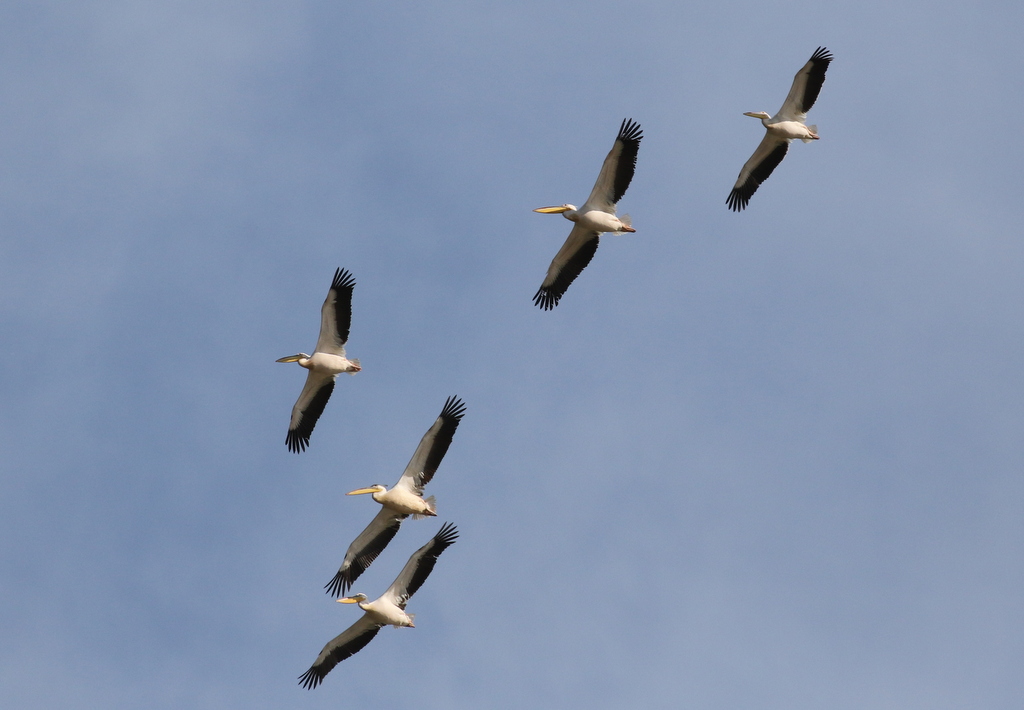
Having turned off the main channel onto Mila 36, we started to come across a lot more birds. There were Kingfishers calling all around here, zooming back and forth across the water and in and out of the trees. We could hear a variety of different birds in the trees, but they were hard to see in all the leaves and undergrowth. An Icterine Warbler and several Eastern Olivaceous Warblers were singing, as well as both Common and one or two Thrush Nightingales, the more grating and clicking phrases of the latter giving them away. Three calling Collared Flycatchers gave only glimpses but a couple of Spotted Flycatchers sallied out of the trees. There were more woodpeckers too, several Great Spotted, another Grey-headed, and we heard out first Middle Spotted Woodpecker.
The Delta is all about its waterbirds, and is packed full of herons of various sizes. There were plenty of Grey Herons and Little Egrets at first and then, as we got further in, we found lots of Squacco Herons which flushed from the banks as we passed, changing instantly from buff-brown to white. Several Black-crowned Night Herons and a smaller number of Glossy Ibis flew over.

We encountered our first Pygmy Cormorants too, but they are very skittish and typically flew off ahead of us. More pelicans circled overhead, mostly flocks of White Pelicans, but we also saw our first Dalmatian Pelican, typically a lone bird which flew over.
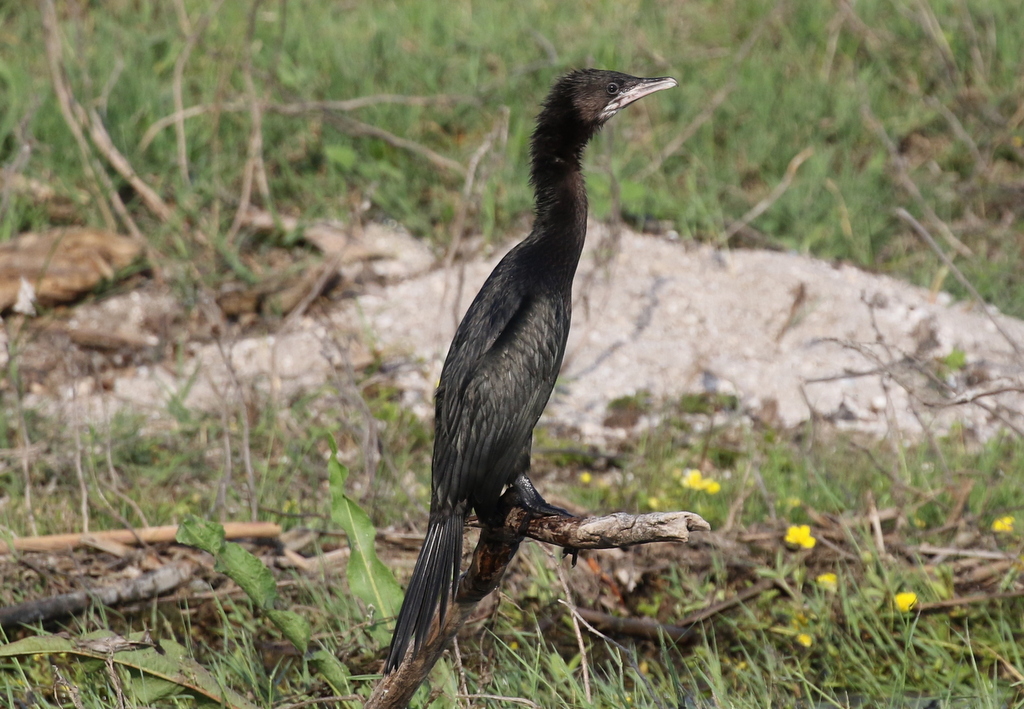
A male Little Bittern flew across the channel ahead of us and landed in the base of the reeds, disappearing in before we could get a good look at it. When we stopped to scan, a Penduline Tit started calling over on the other side, and we saw it perched briefly in the top of the reeds. One of the group, scanning for the tit, found a female Little Bittern instead, up on top of the reeds further back. We had already heard several Great Reed Warblers singing in the reeds as we passed, and now one perched up nicely on a dead reed stem. A little further on, and a pair of Hobbys were zooming around through the tops of the trees beside the channel, before landing up in a poplar.
We stopped for coffee at the entrance to Lake Nebunu. As we motored up, a Raccoon Dog was on the bank nearby, but quickly scuttled into the vegetation. There were lots of Mute Swans and Great Crested Grebes out on the lake. A pair of Common Terns and about 15 Whiskered Terns were flying round and dip feeding over the vegetation across the entrance. We could see lots of cormorants and herons coming and going from their nesting colony in the tall trees at the back. Two White-tailed Eagles appeared over the trees, and one was mobbed by a Hooded Crow, which was just a tiny speck by comparison at that range. A Pallas’s Gull flew over the back of the lake too, like an oversized Black-headed Gull, but it was rather distant and disappeared from view behind the trees.
After coffee, we carried on along the channel and hadn’t gone much further when we came across our first Red-necked Grebes. The first one dived ahead of the boat and disappeared into the reeds, but then we found four more together, and had a great view of them, resplendent in breeding plumage with bright rusty-red necks.
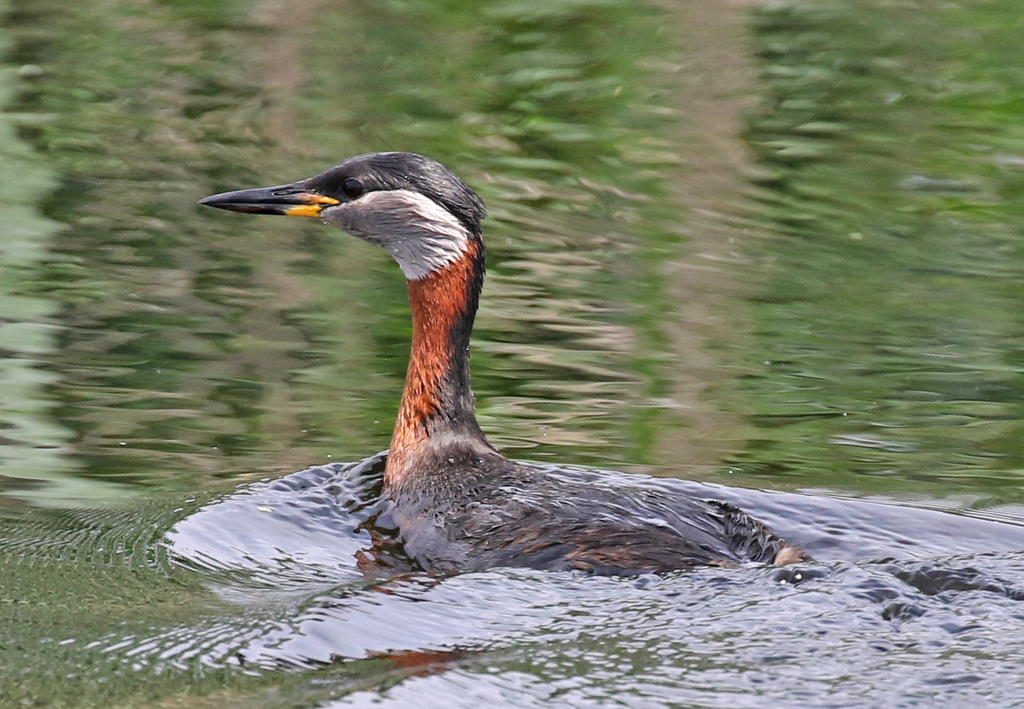
Next stop was by a White-tailed Eagle nest, which was high in the trees beside the channel. One of the two juveniles was still on the nest, but the other was hiding higher up in the branches above. They were almost fully grown, not long to fledging now. There was no sign of either of the adults at first, until two White-tailed Eagles appeared through the treetops. One of the adults was chasing off an immature, which had presumably flown too close to the nest. Once the intruder had fled, the adult flew back round and landed in a tree not far away.
We cut back across Lake Furtuna, a large open lake surrounded by reeds. Several White Pelicans and a single Dalmatian Pelican were swimming out on the water. There was more floating vegetation over the far side, where we found lots of Whiskered Terns, four Garganey and a pair of Gadwall. It was full of grebes too, nesting Great Crested Grebes, several pairs of Black-necked Grebes and four Red-necked Grebes too. Our first Purple Heron flew over.

On the smaller channels especially, there were Cuckoos and Rollers everywhere. A brief Golden Oriole flew over, but was not seen by most of the group and would remain a target for a good view for many for a while yet. There were lots of dragonflies – mainly Emperor, Lesser Emperor and Scarlet Darter, and plenty of Banded Demoiselles beside the channels. As we got out into a more agricultural area, several Western Yellow Wagtails flew up from the feet of a herd cows, though it was hard to see for sure whether these ones were pure Black-headed Wagtails or one of the array of hybrids.
We met the floating hotel for lunch at Maliuc, and while we were settled on board enjoying our three course feast we were towed slowly along to the next location. After lunch, we had a couple of hours to relax over the heat of the day, take a siesta or watch the world go by from the boat. The banks were more open here and in the wetter spots there were lots of Great White Egrets and Glossy Ibis. Three Hoopoes flew alongside as we passed and there seemed to be Rollers on just about every bush.
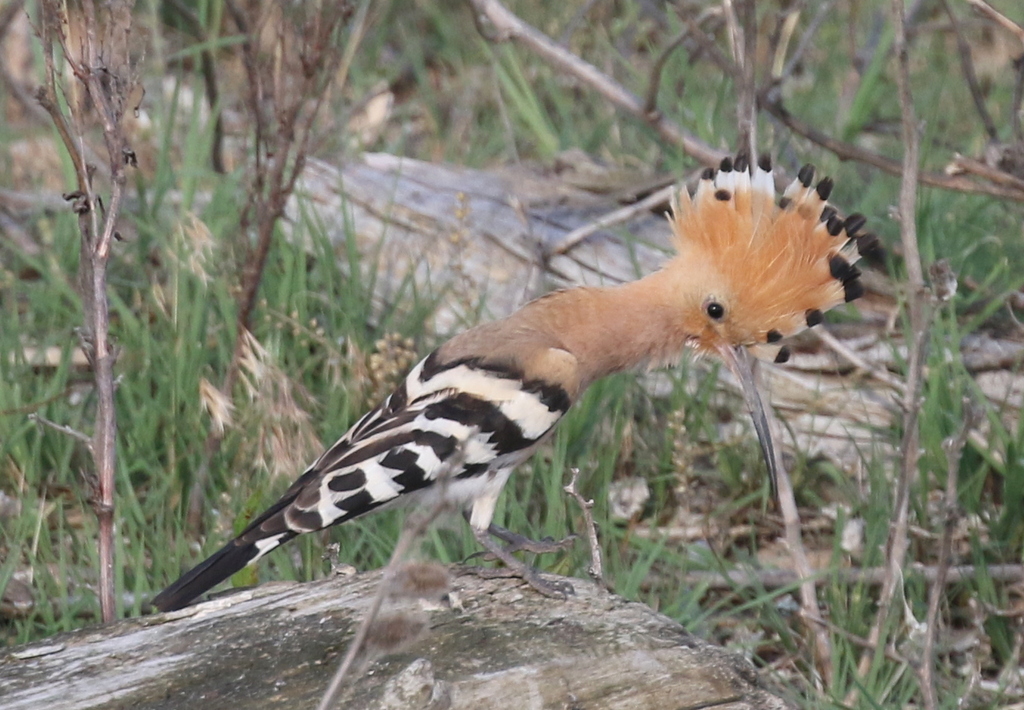
With the floating hotel moored again, we set off about 5pm in the smaller boat to explore the area. A Penduline Tit was calling from the trees on the opposite bank and a Garden Warbler was singing from the trees on our side. It was still hot, and quiet to start as we checked out a couple of smaller lakes.
The first was overgrown with Water Soldier and not surprisingly there were several Norfolk Hawkers patrolling along the edge of the reeds. Marsh Frogs were everywhere on the lily pads, until a Dice Snake swam across, causing them to disappear into the water. Lots of herons were flying around again, and we saw many more Purple Herons out here. A Savi’s Warbler was reeling from the reeds, the first of many we heard this afternoon.
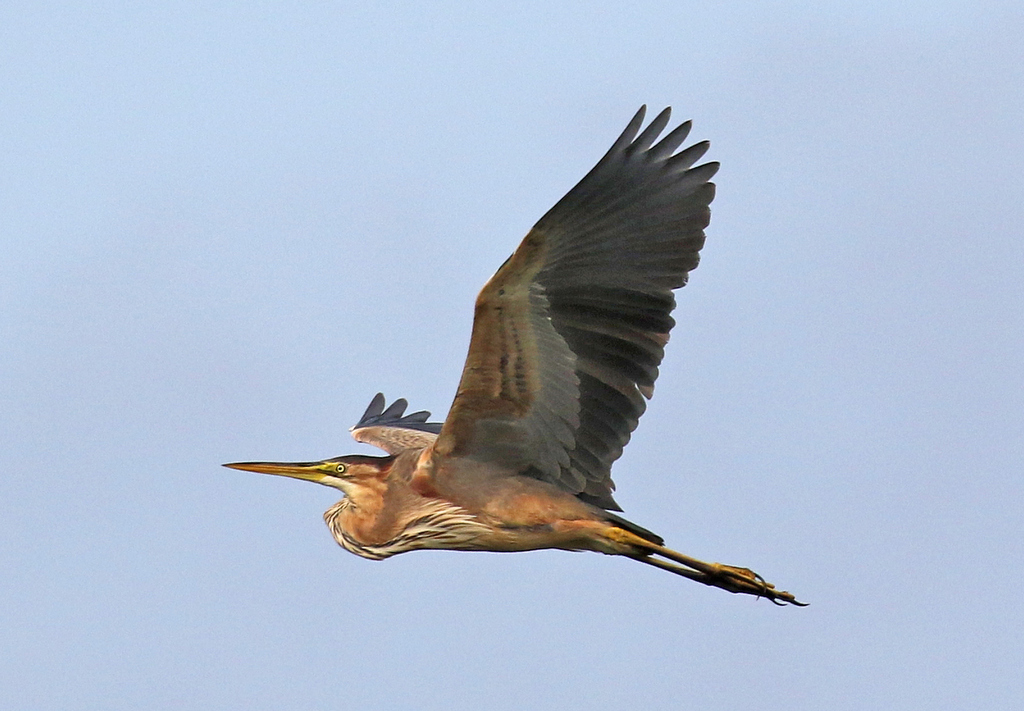
The second lake was full of Whiskered Terns, looking to nest on the floating vegetation. When a Hooded Crow flew across, they all came up en masse to mob it, and we realised just how many had been hiding there. A pair of Greylag Geese lurking in the edge of the reeds at the back had distinctive pink bills, birds of the eastern race rubirostris. We could hear a Bittern booming too.
Back along the more open Crisan channel, an obliging Black-crowned Night Heron was standing on the floating vegetation below one of the trees on the bank. We saw several more Ferruginous Ducks, mostly typically flighty, but we had a nice view of a male down on the water’s edge which lingered longer than most. On an area of open sandy shore, an adult Little Ringed Plover was keeping an eye on its already well-grown juvenile. A White-tailed Eagle flew in over the back and appeared to be coming our way before it suddenly dropped down onto the ground. We could see it was feeding on something, and was quickly surrounded by 10 Hooded Crows.

We continued on back past the floating hotel, and turned in down the small channel leading to Lake Iacob. There were more pelicans on the lake – with two White and two Dalmatian Pelicans on a log, giving us a nice comparison. A Garden Warbler was singing nearby and we could hear more Penduline Tits calling. As we motored back slowly along the wooded channel, a Grey-headed Woodpecker perched nicely in the tree above us. Another Pallas’s Gull flew over, much closer this time but we would still hold out for better views.

Back at the floating hotel, we sat out on the deck to compile the list for the day. We could still hear the Grey-headed Woodpecker calling away in the trees. Eastern Olivaceous and Great Reed Warblers were singing and the Savi’s Warbler was still reeling. A Bittern was booming off in the distance and a Golden Oriole was taunting us, hidden deep in the bushes. What an amazing place to be! After a delicious three course dinner of salad followed by local zander, it was time to turn in, to the sound of Fire-bellied Toads calling.
MONDAY 3RD JUNE
Before breakfast, the earlier risers gathered out on the deck. A Little Crake was calling, but hidden deep in the reeds beyond the trees on the bank. A pair of Eastern Olivaceous Warblers appeared briefly low in the branches, before making their way through to the sunny side of the trees as the early mist burned off. The Bittern was still booming and the Savi’s Warbler still reeling off in the distance. Three Pallas’s Gulls flew high over, one at a time, and the first White Pelicans flapped lazily up along the channel. A Middle Spotted Woodpecker flew past through trees opposite and while we ate breakfast, a pair of Garganey circled round over the water outside.
As we got ready to set off on the smaller boat again, we picked up a distant male Red-footed Falcon on some wires, and through the scope we could just about see its red feet and legs in the morning sunshine. As we motored slowly up the channel, there were the usual herons and egrets everywhere. A Great Bittern flew across and up the edge of the channel ahead of us, a difficult bird to see here.
When we heard Bearded Tits calling we looked over to see a family party right up in the top of the willows on the bank. Another bigger group of Bearded Tits were in the reeds on the junction of the Caraorman channel, lots of juveniles. As we stopped to look at them, one of the group noticed a male Penduline Tit feeding in the sedges right down at the front – nice to get our first good views of this species. We could hear a Reed Bunting singing, and then a pair appeared in one of the willows. The birds here are a different race to back home, tshusii, being noticeably heavier-billed.
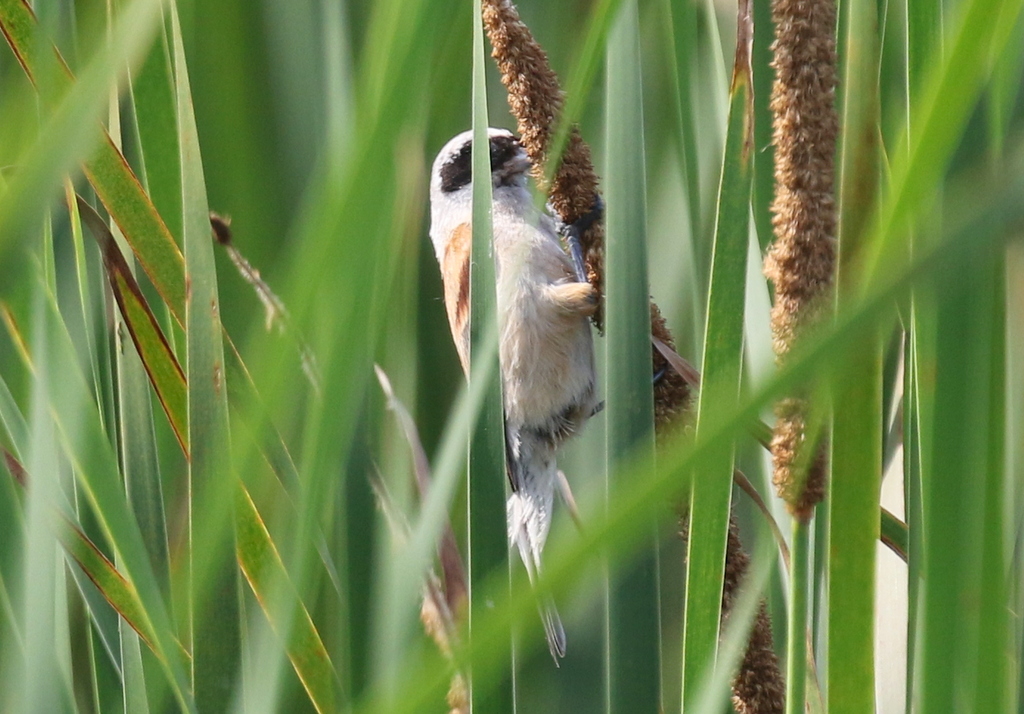
Continuing on to Caraorman village, a pair of Caspian Gulls were loafing on the bank and a Hoopoe was wrestling with a mole cricket as we made our way down to the small harbour. The vista here was dominated by the ruins of the old communist-era industrial sand mining site, long since abandoned. As we got out at the harbour, a juvenile Northern Wheatear was feeding in between the boats pulled up nearby. Walking down the track towards the village, we were surrounded by Bee-eaters calling and perching on the wires, nesting in the low sandy banks.
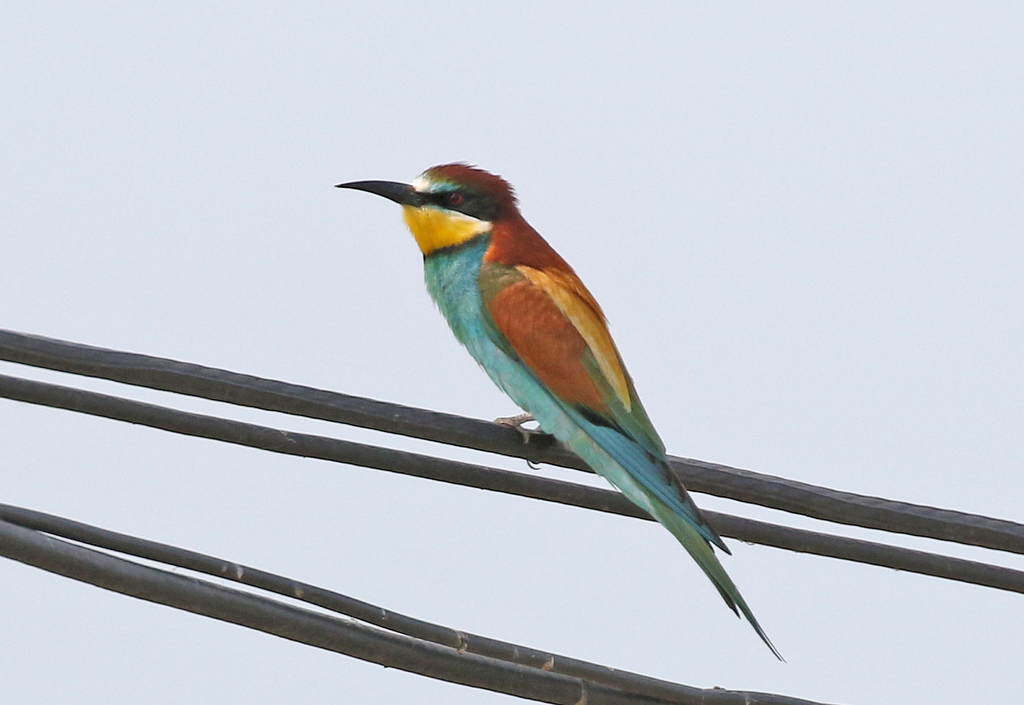
A couple of Black-tailed Godwits were feeding in a grassy pool out where the cows were grazing. Three Red-footed Falcons were perched on the wires further down, two of the males chasing each other a little closer before landing again. It was already starting to get hot. Lots of Marsh Frogs were basking around the edge of a small pool in the sand, before hopping in as we passed, and the head of a Dice Snake appeared out of the water.
Several White Storks were on nests in the village, and one stood bill clapping and throwing its head back as two others circled over. It was eerie walking round past the huge abandoned accommodation blocks, long-since stripped of windows, doors and any other removable fittings, their roofs falling in but providing nest sites for the local Kestrels.
We continued on down the track out into the old sand pits. On the larger shallow pools here we found several Avocets and Black-winged Stilts along with more Black-tailed Godwits and a few Shelduck too. A Hobby flew over hunting dragonflies. Up on the bank of the next basin, there was pleasant breeze to stop us overheating. A single Caspian Tern was out in the middle, dwarfing the Common Terns and Whiskered Terns it was with. Through the scope, we could see its huge black-tipped red bill. A few Black-winged Stilts and Common Terns were nesting on the sandy islands.
Continuing round to the far corner, we could see a group of larger gulls loafing on the edge of the another pool. A single adult Pallas’s Gull was in with the Caspian Gulls – with its black hood, it really stood out. There were more Bee-eaters in the bushes and a male Red-backed Shrike appeared with them briefly. Then it was time to get out of the sun, so we took a short cut back to the boat. A male Northern Wheatear was singing around the abandoned factory buildings.
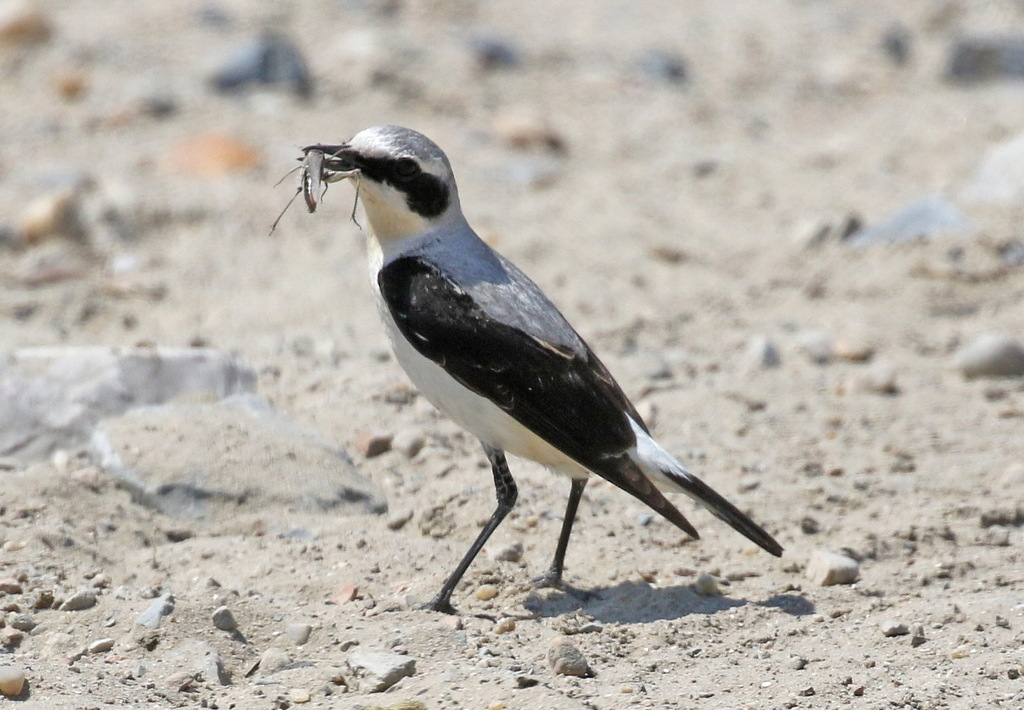
After a break for water and/or coffee back at the boat, we motored round to a former fish farm nearby. There were lots of Whiskered Terns flying round over the pools, but a group of people had set up for a picnic at the viewing platform, so we carried on down the channel. We went looking for a Penduline Tit nest. The reeds were too tall at the first site we tried, but we did see the pair of adult Penduline Tits in the trees calling. Further on, we found another nest hanging in the lowest branches of a willow, just above the reeds, an amazing construction. The remains of last year’s nest was still hanging in the branches further in. It was all quiet here though, so perhaps the female was incubating.
Continuing on, we stopped to look at a pair of Red-backed Shrikes in the bushes on the bank. An Eastern Olivaceous Warbler was singing here too, and perched up in the top of a bush for ages, being unusually obliging. Back round to Caraorman channel, a Common Cuckoo perched on the wires.

As we headed back towards the floating hotel, we heard another Savi’s Warbler reeling. This one seemed to be closer, and a careful scan revealed it perched up in the reeds in full view. We stopped the boat and had a good look at this typically very elusive species. We certainly would not go hungry this week – lunch was another three courses of soup with meatballs, followed by stuffed vine leaves and a delicious traditional pudding.
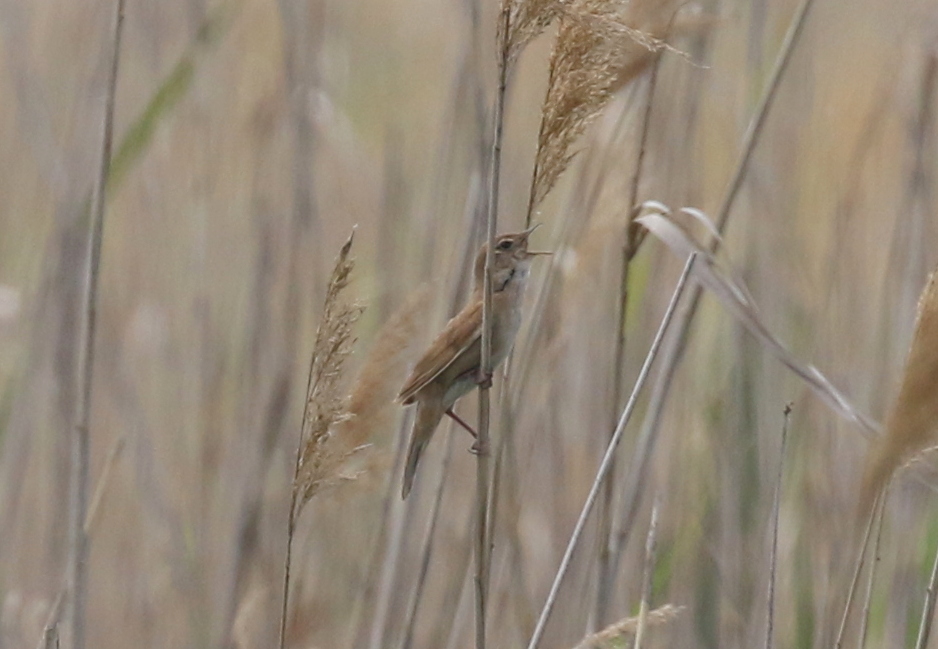
After lunch, the floating hotel was towed slowly back up to the main channel at Crisan before turning onto the course of the old Danube. Here we got back onto the smaller boat again, to head out for the afternoon. As we motored slowly along a side channel, we could hear several Golden Orioles fluting from some very tall poplars. We saw a couple flying in and out through the treetops, but you had to be quick to get on them. Both Grey-headed Woodpecker and Lesser Spotted Woodpecker were calling here too, but there was no sign of any Black Woodpeckers today.
The usual selection of herons flew out of the trees beside the channel as we passed, and a Little Bittern flew out of the reeds and alongside the boat, before crashing back in. We were still waiting for a really good view of one perched in the reeds. Turning on to Bogdaproste channel, Common Cuckoos were everywhere again. Several Hobbys zoomed in and out of the trees on the banks, and one perched up nicely.
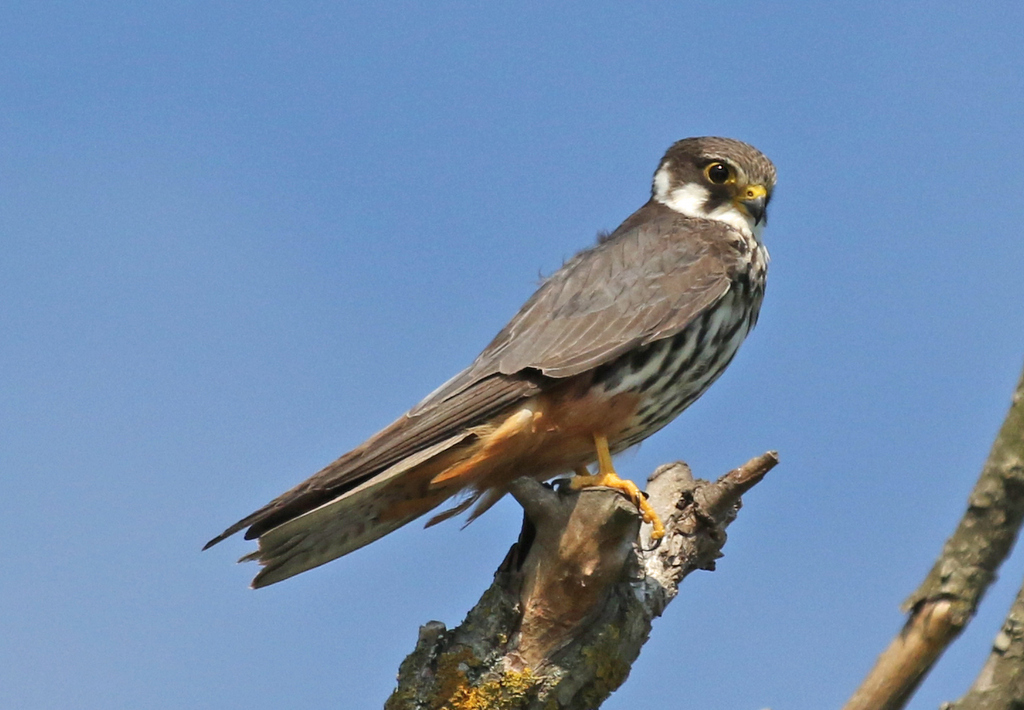
There were lots of Rollers here too – one pair was coming in and out of a nest hole in a tree, and another male was bringing food for the female. An Otter was floating in the channel ahead of the boat, crunching on something it had just caught. As we cut the engine, it saw us and dived.

The water opened out into Lake Bogdaproste, where we found a scattering of White Pelicans and Pygmy Cormorants, plus rafts of Common Pochard and Eurasian Coot. Two Black Terns flew over calling behind the boat, but disappeared away from us before we could get a good view. We could see several distant Pallas’s Gulls circling and as we motored across the lake we noticed one on the water, so we diverted over for a closer look. We got much closer before it took off – a very smart gull with its black hood and black-and-white wing tips, and multi-coloured yellow bill.
Through the channel on the far side, we found ourselves coming out into another large lake. As we were crossing, we could see some very distant Whiskered Terns hovering over an island of vegetation on the far side, and we picked up a White-winged Black Tern in with them, so we headed over for closer look. As we got nearer, we could see there were actually two White-winged Black Terns and lots of Black Terns too, at least a dozen, loafing on the floating vegetation. We had great views of one of the White-winged Black Terns dip feeding beside the boat – a real bonus, as they are not common here, with just a few pairs breeding in inaccessible areas. All the terns then took off, and flew round over the boat.
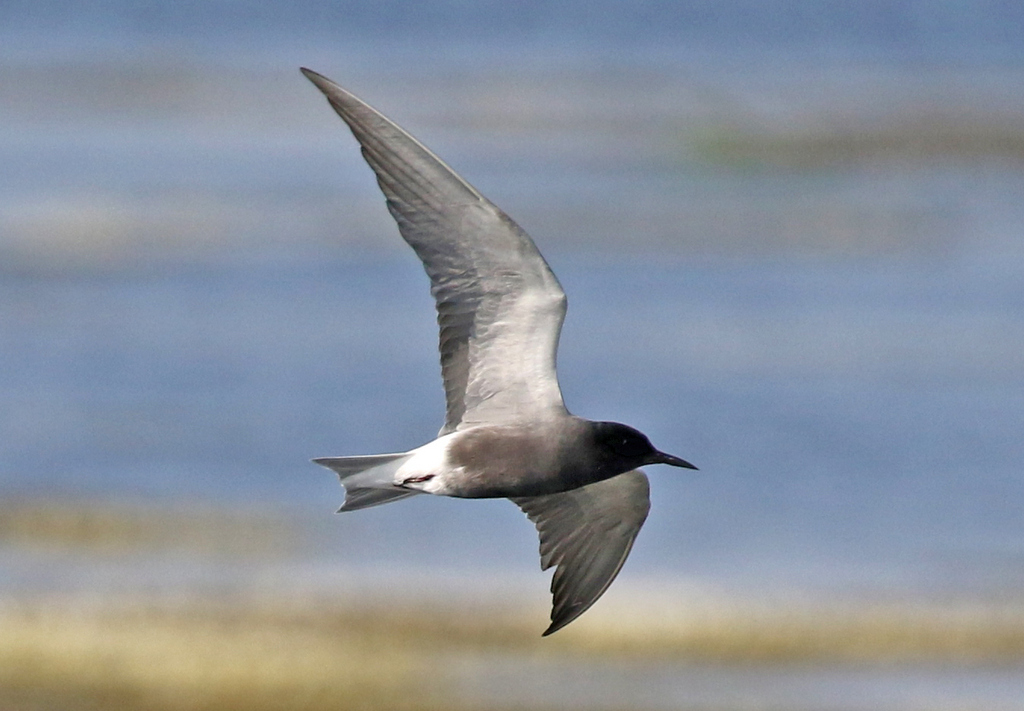

Continuing on to the next lake, a pair of rubirostris Greylag Geese swam across in front of the boat with four goslings. An amazing number of Whiskered Terns, probably at least 150 pairs, were starting to nest on carpet of floating vegetation here. We sailed along a channel through the middle, and had amazing views of them flying all round the boat, calling noisily. What an experience! A Hooded Crow flew over, and was immediately chased by a horde of Whiskered Terns. It made repeated visits, looking for eggs. Two Black-necked Grebes swam along the channel ahead of us.

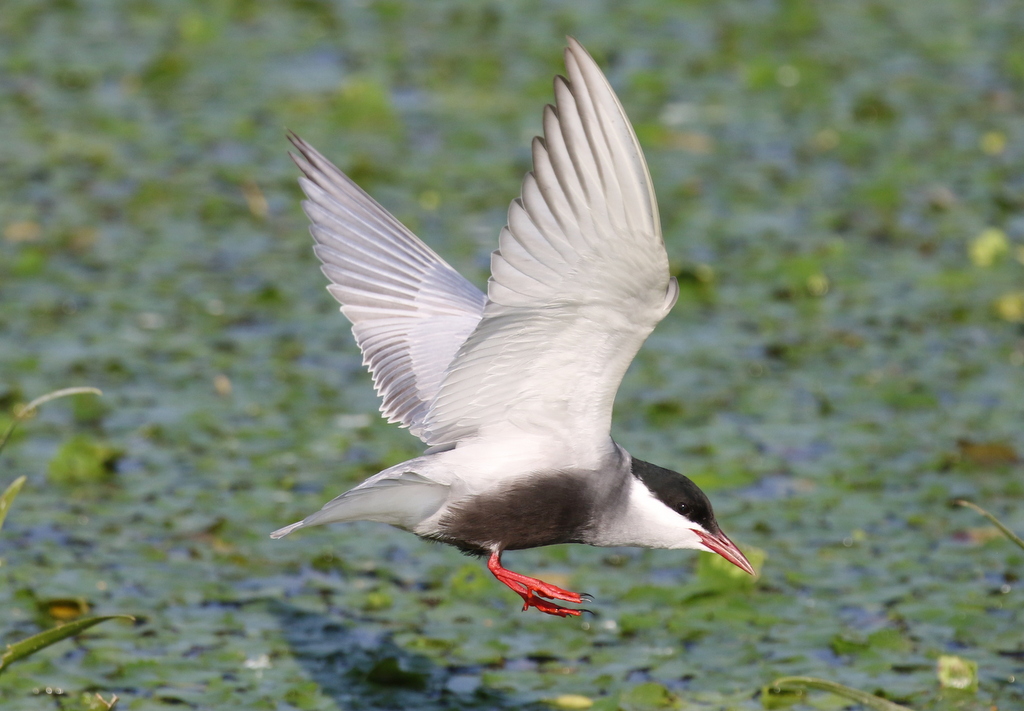
As we sailed back through the lakes, there were lots of Great Cormorants nesting in the surrounding trees. One tree on the edge of the reeds was full of cormorants of two species, Great and Pygmy Cormorants side by side, so we could really appreciate the size difference. Another Pallas’s Gull was swimming ahead of us on the water, and allowed us to approach closer still before it finally took off and flew round past us. Then we headed back to meet the floating hotel which was moored on a different channel nearby.
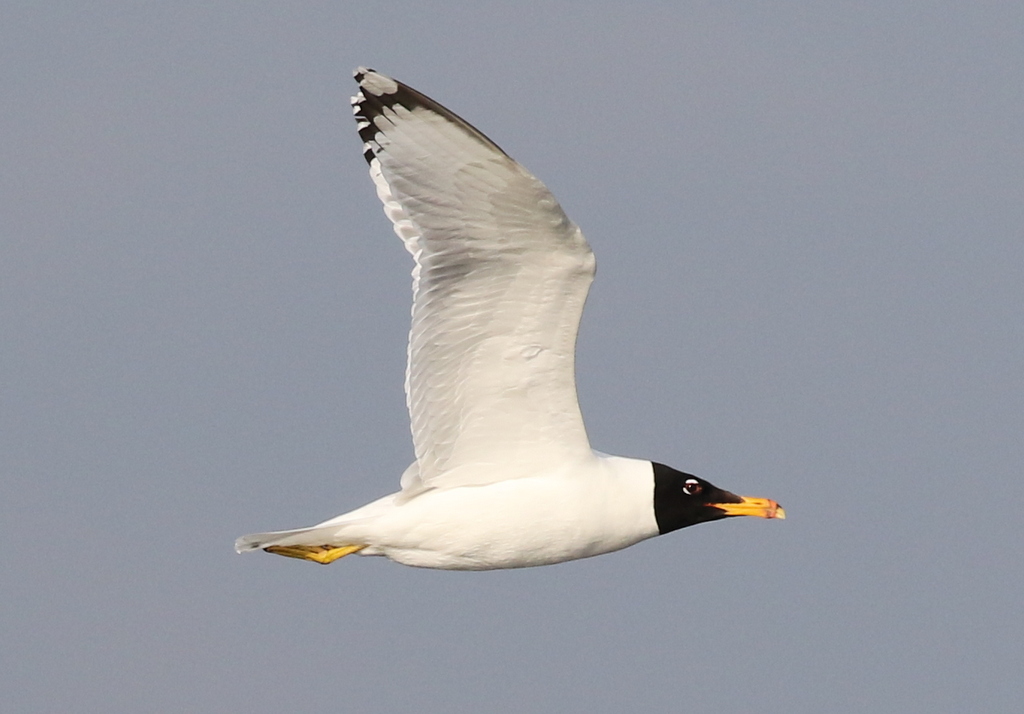
After a break to freshen up, we met up on deck to do the day’s list. A group of eight White Pelicans was loafing and preening on a log by the boat, Whiskered Terns and Marsh Harriers were flying round, another Savi’s Warbler was reeling in the distance, and several Great Reed Warblers were singing in the reeds nearby. After dinner of salad, breaded chicken and local cake, we retired to a deafening chorus of Marsh Frogs outside. Another amazing location and a privilege to be able to spend the night out here again.
TUESDAY 4TH JUNE
Up on the deck before breakfast, we spotted a White-tailed Eagle which had obviously roosted in a tree a short way back along the channel. Three Black Terns patrolled up and down the channel past us and we could hear Bearded Tits and Penduline Tit calling from the reeds, and the Savi’s Warbler was still reeling.
After breakfast, on the smaller boat we headed down to look at the White-tailed Eagle. It eventually took off, and flew back upstream, where it caught a fish and landed on the floating vegetation nearby to eat it. We turned round and motored back and had a great view of it feeding, before it eventually flew again.
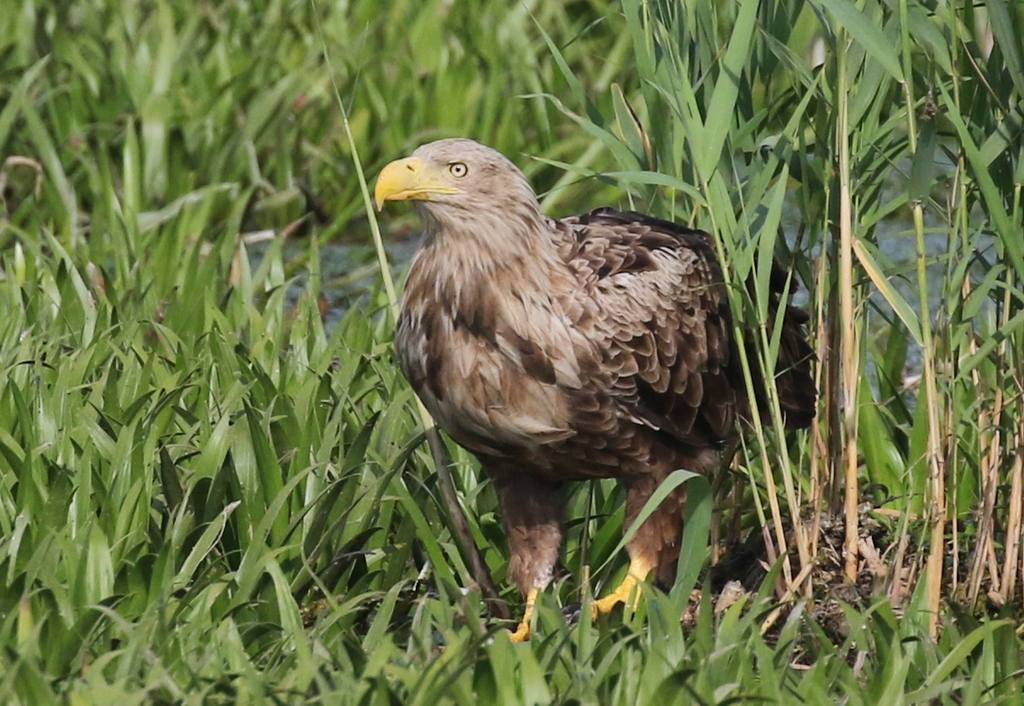 White-tailed Eagle – caught a fish j
White-tailed Eagle – caught a fish j
















